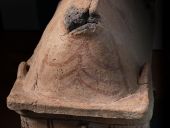...In the bo(a)tanical garden
The flowers on the short side of the larnax resemble a rather schematic version of the typical ‘Minoan flower’, which usually consists of a stem, two petals, pistil, and stamen. On this larnax the flower has been reduced to a reversed hooked stamen and three rows of paired petals. The stamen is the pollen-producing reproductive organ of a flower , and as such the flower can be taken to denote fertility and regeneration. The motif is well-attested in Minoan art, not only on funerary items but also on pottery and frescoes. The straight lines, on the other hand, refer to the panel-design that was present on the original wooden larnakes.
When maritime images frame on-land scenes, such as the flowers on the short sides of this larnax, it can be seen as a reference to the location of the hereafter. These religious symbols also mark the sanctity of the coffin and are intended to protect it from evildoers.
In their larnax, the dead could traverse safely across the sea to the eternal lands. Before you traverse to another story, you are invited to read up about the restoration of this larnax.

](https://micrio.thingsthattalk.net/PcjLu/views/max/128x128.jpg)